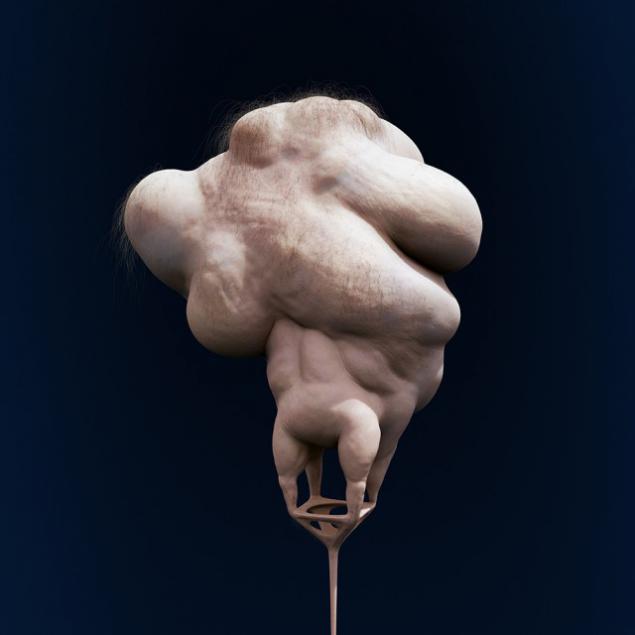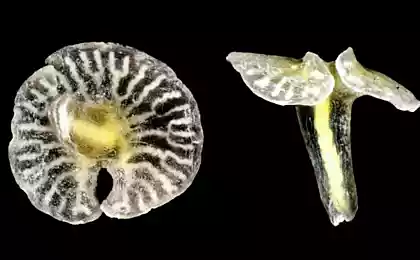908
10 post-human beings who can inherit the Earth
To pass planetuGomo sapiens have long and firmly occupy the position of the "crown of nature", however, as rightly noted Shakespeare, nothing lasts forever. We decided to make a few assumptions about who might "reign" of the planet after the era of mankind will be completed.

1. developed were zhivotnyeIdeya nurturing animal species with human intelligence is not new and dates back to the "Island of Dr. Moreau" by HG Wells. Kordveyner Smith presented the developed animals as the oppressed class fighting for their rights, and a series of "War of the rise of" David Brin introduced a universe in which almost all sentient beings owe their mind patronizing kinds, and people explore the world with intelligent apes and dolphins.
Some theorists, such as George Dvorsky, say that we have a moral imperative to elevate other types to our level of intelligence, as soon as we obtain the necessary facilities. Dvorsky indicates the current efforts to ensure the great apes legal right "to the person", and argues that the natural next step is to give other animal cognitive abilities for self-determination and participation in society of living beings. Human monopoly on rational thought gives us an unfair advantage over other animals, creatures, and if there is a way to help the dolphins, monkeys and elephants find a reasonable idea, it is our moral duty.
Others disagree. Alex Knapp believes that from the point of view of animal life costs would be too high to justify it. In order to elevate the view will have to make changes in fetal DNA level, which will lead to an inevitable unsuccessful attempts before we succeed. Again, the question arises, how to make sure it will stand successfully elevated the embryo. Such experiments can be morally incorrect, if not lead to what is reasonable animals will suffer because of deviations and early death as a result of human intervention. Even if successful, human beings will not be able to provide the necessary social and emotional environment for intelligent chimpanzees, bonobos and parrots. In other words, the sublime animals can be emotionally traumatized as a result of clumsy attempts of people to nurture them.
Some are also concerned about specific aspects of the problem, such as chimpanzees and brutality dolphins propensity to rape, they do not prevent them in reasonable ways. It is also believed that the intellectual self-awareness is an ecological niche, which can hold only one type, which explains the destruction of Neanderthals and other relatives of the person. The emergence of intelligent animals can create an evolutionary competition with people and creatures corrupted the system of mentality and values that we simply will not be able to understand.
2. Borg "Star Trek" introduced the race of cyborgs who sought to unite all intelligent species in the universe into one collective mind. Many would come to the conclusion that it is bad, but some disagree with this outcome. Travis James Leland claimed that unemotional, sterile picture of Borg - this is some ludditskaya propaganda - and step forward to the collective wisdom will lead to happiness and freedom of all members of the hive. In fact, one of the reasons why we go to the Internet and social media - is to be closer and in connection with his views, it is a manifestation of the collective in its purest form.
Integration and interconnection technologies do not reduce identity; they simply allow us to communicate and express their individuality in the emerging global consciousness. Some argue that technology is creating a "telepathic noosphere" is now available with our current technology. We can already send video, audio and motor information between the brain and the Internet through the electrodes, and the information-carrying capacity necessary to swarm intelligence, too, could be available. The technological infrastructure used to modern telecommunications and wireless internet can further develop into neural interfaces, although initially they will be inaccurate and would be difficult to use. Some call these theoretical swarms minds "borganizmami" and in favor of the creation of social and political reasons.
In the collective mind may well be a lot of advantages because it essentially allows us to become a superhuman being, capable of feats beyond the ability of individuals. The ability to coordinate a massive rise projects, planning challenges will be more effective, and people will understand each other better.
Of course, there are a number of disadvantages. Along with the existential fear of loss of identity in the public mind, a threat of viruses and hackers in the early stages, not to mention other worries like that, who exactly will manage the technology. Developed swarm intelligence of social media will be very different from the swarm intelligence soldiers and secret services, designed for military purposes. Some believe that the developed borganizmy are quite vulnerable to dangerous memetic infection (which would require the development of a tough "mental health"); It will also need to deal with social parasitism and selfishness Group within the hive.
3. Genetic kastyPolitolog Francis Fukuyama believes that transhumanism - this is one of the most dangerous ideas soaring today. He sees the principal danger in an attempt to improve our basic humanity. He calls it "factor X» and says that "it can not be reduced to a moral choice, reason, language, sociability, awareness, emotions, establishment or any other quality, which is put forward as the basis of human dignity. All these qualities combined in man, and constitute a factor X ».
Fukuyama believes that the development of genetically modified people will mean the end of liberal ideas of political equality of all people. Access to the technology of genetic modification will result in genetic castes and undermine our common humanity, the rich will be able to create designer children with abilities that go beyond the ability of other, less affluent masses. Fukuyama is conservative, but many share his fears. Genetics Society expressed fears that "tehnoevgenika" will lead to the formation of the gap between the "gennobogatymi" and "gennobednymi».
Some argue that the complexity of the genetic modification and the cultural aversion experiments on children doing such a scenario aloveroyatnym. Others say that even if he is, he will not be transferred to the political plane, since political rights do not depend on physical features. However, questions remain about the fact whether the parents the right to choose the physical and intellectual traits for their children. This may include choice of IQ, height, gender, and even color.
Science designer babies already exists in the field of preimplantation genetic diagnosis and in vitro fertilization, which are gaining popularity in the light of prevention of genetic diseases. Some fear that the taboo of technology in the light of fears of the emergence of genetic castes may make the problem worse, and the rich will still be able to travel to a country where not prohibited by editing the genes of children.
4. Grey slizV 1986 engineer Eric Drexler sow fear nanotechnology uprising against the human race. Although he described the many potential benefits of nanotechnology, such as the destruction of cancer cells and DNA repair, he also expressed concern that self-replicating robots the size of a molecule can displace plants and micro-organisms, taking all ecological niches and eventually consume all earthly resources: script so called "gray goo" is also known as the "global ecophage».
Concerns such predictions led to the convening of the "Nanotechnology Summit" forces of Prince Charles at his estate in Gloucestershire. Nenotehnologi like Richard Smalley said that such "molecular manufacturing" to create nanobots is not possible from a scientific point of view. To manipulate the atoms (which are sensitive to electronic communications surrounding atoms), molecular assemblers need to have additional manipulators, "fingers", but their place at the atomic level is not there. This so-called problem of "fat fingers". There is a problem and "sticky fingers": the atoms, move the manipulators can firmly stick to them. Drexler himself in response to comments Smalley thought that he just wants to reduce public fears and to protect funding for research in nanotechnology.
One of the solutions proposed in the light of the protection of the mythical gray goo, include other forms of nanotechnology: the blue slime. It should be self-replicating nanobots from the police, which will destroy an autonomous and not a good gray goo. However, they must also be ubiquitous, strong, reliable and resistant to sulfur mucus, while remaining under the control of people. Because if the blue slime absorbed or move to the side of the gray goo, it may well turn against us.
Other potential restrictions on the distribution of gray goo includes limited samovoproizvodstva or the use of rare elements such as titanium or diamond in the production of molecular assemblers. Since the human body contains a few of these rare elements, mucus is unlikely to extract them from us, except that devour our smartphones. If anything does not work, the world is flooded with swarms of nanobots.
5. intellektIskusstvenny Artificial Intelligence - is a subdomain of computer science, whose task is the creation of machines that can perform tasks at a level comparable to human intelligence. There are two forms of AI theory: a narrow, narrow, weak or soft AI and overall, obschenapravlenny or strong AI. Soft AI is inspired by the human brain, but does not try to imitate it - is statistically oriented machine intelligence capable of sorting data using various algorithms and to play chess, to answer quiz questions, make orders and give directions by GPS. Tasks that perform this intelligence, bear little resemblance to the way people solve them.
Strong AI is designed to simulate the human intellect in reasoning, planning, training, visualization and communication in natural language. Proponents of strong AI hope to reach the singularity, the point at which the car catch up and surpass human intelligence, after which technological progress will go up rapidly, and we will be unable to predict or even understand the future of civilization.
Entrepreneur Elon Musk is very worried about the risks of artificial intelligence: "In the movie" Terminator ", they did not create AI, waiting for such an outcome. It is something out of Monty Python: nobody expects the Spanish Inquisition. Nonsense, of course, but you need to be afraid. " And he is not alone. Bill Gates has expressed similar concerns, Stephen Hawking sees everything in a more somber light of "primitive form of artificial intelligence, which we have, turned out to be useful. But I believe that the full development of artificial intelligence would mean the end of the human race. Once people develop artificial intelligence, he will remake his own. People, limited slow biological evolution will not be able to compete and will be replaced ».
Many scientists dismiss these fears as exaggerated and consider that the development of artificial intelligence will complement the humanity, not destroy it.
6. ProvodogolovyeProvodogolovy (wirehead) - is the idea of science fiction, which includes the individual, stimulates the pleasure center of the brain electrical current and thus dependent. The idea first appeared in the "Known Space" by Larry Niven in the 1970s, but has since become a common theme in cyberpunk. The roots of it go, probably in experiments 50s, when James Olds placed electrodes in the mesolimbic dopamine tracks rats. The rats stopped eating and sleeping in favor of endless fun flashes until dying of hunger. Olds repeated these experiments with other animals and people, who later described the experience as "orgasmic».
Some believe that the adoption of this technology will help to cope with the suffering, manifested in the process of getting life experience, without hurting others or the environment. It is the dream of so-called project Abolitionist, who is looking for a way to combine the wire with the head developed drugs (narcotics) and genetic engineering to create the perfect society. However, doubtful orgasmic bliss is likely to lead to global extinction, so the idea is not without drawbacks. Wearable technology can allow you to change the mood and state of mind to calm an excited or no side effects, or all sorts of drugs. The technology is Thync transcranial brain stimulation DC, inexpensive way to send an electric current to the brain in order to improve intelligence, learning, alertness and memory. He also helps with chronic pain, depression, schizophrenia, Parkinson's and fibromyalgia.
And yet, futurists do not lose hope to get another form of mind-altering technology: transcranial magnetic stimulation. This technology can be used to stimulate psychopathy, temporarily disable the part of the brain responsible for fear, or for clear thinking while intoxicated. There is a fear that in the future people will be able not only to adjust the mood, but also turn off the fear and sympathy, if necessary. Although these concepts may not be genetically identical to modern humans, their emotional and social worlds can become unrecognizable strangers.
7. InfomorfyV 1991, Charles Platt has published "The Man from silicon," a book about the quest for immortality by copying the human mind in computers, of which created beings called "infomorfy." In 1996, Russian theorist Alexander artificial intelligence Chislenko borrowed the name to describe the theoretical nature, it is based on a distributed intelligence. Such networking minds could easily share knowledge and experience than we do, which would lead to massive changes in the concepts of identity and individual, like swarms of consciousness, which we discussed above.
Not limited to physical organs, these entities would have found many human notions alien and meaningless, even strange. The term is also used to describe the load of human consciousness into computers to create backup copies of the human brain. The psychic structure of man is transferred from the biological matrix in the electronic or information. Benefits include load consciousness growth, the ability to reprogram yourself to heighten the mind or happiness, reducing the impact on the environment and freedom from the laws of physics, and the inevitability of death.
There are many potential problems associated with the loading of consciousness and go beyond our human form. Technical arguments include the impossibility of reproduction of unpredictable and non-linear interactions between brain cells that make up the human intelligence, not to mention the fact that we have no idea what consciousness. There are also ethical problems in the development of this technology. For example, we can never know whether it really is: we understand that the loaded consciousness really aware of themselves, and not imitate human behavior, not having any mental state? The threat of abuse and manipulation is also informorfami neillyuzorno.
8. Transgenic animals have lyudiTransgennye foreign gene intentionally incorporated into their genome. This technology was used to create glowing in the dark mice and fish. This technology has been used in attempts to revive the woolly mammoth and the debate on the use of transgenic primates do not stop. Ahead of the prospect of transgenic people who will benefit from the use of genes of other animal species.
The advent of transgenic people require a series of steps.
via listverse.com/2015/06/10/10-post-human-entities-who-could-inherit-the-earth/

1. developed were zhivotnyeIdeya nurturing animal species with human intelligence is not new and dates back to the "Island of Dr. Moreau" by HG Wells. Kordveyner Smith presented the developed animals as the oppressed class fighting for their rights, and a series of "War of the rise of" David Brin introduced a universe in which almost all sentient beings owe their mind patronizing kinds, and people explore the world with intelligent apes and dolphins.
Some theorists, such as George Dvorsky, say that we have a moral imperative to elevate other types to our level of intelligence, as soon as we obtain the necessary facilities. Dvorsky indicates the current efforts to ensure the great apes legal right "to the person", and argues that the natural next step is to give other animal cognitive abilities for self-determination and participation in society of living beings. Human monopoly on rational thought gives us an unfair advantage over other animals, creatures, and if there is a way to help the dolphins, monkeys and elephants find a reasonable idea, it is our moral duty.
Others disagree. Alex Knapp believes that from the point of view of animal life costs would be too high to justify it. In order to elevate the view will have to make changes in fetal DNA level, which will lead to an inevitable unsuccessful attempts before we succeed. Again, the question arises, how to make sure it will stand successfully elevated the embryo. Such experiments can be morally incorrect, if not lead to what is reasonable animals will suffer because of deviations and early death as a result of human intervention. Even if successful, human beings will not be able to provide the necessary social and emotional environment for intelligent chimpanzees, bonobos and parrots. In other words, the sublime animals can be emotionally traumatized as a result of clumsy attempts of people to nurture them.
Some are also concerned about specific aspects of the problem, such as chimpanzees and brutality dolphins propensity to rape, they do not prevent them in reasonable ways. It is also believed that the intellectual self-awareness is an ecological niche, which can hold only one type, which explains the destruction of Neanderthals and other relatives of the person. The emergence of intelligent animals can create an evolutionary competition with people and creatures corrupted the system of mentality and values that we simply will not be able to understand.
2. Borg "Star Trek" introduced the race of cyborgs who sought to unite all intelligent species in the universe into one collective mind. Many would come to the conclusion that it is bad, but some disagree with this outcome. Travis James Leland claimed that unemotional, sterile picture of Borg - this is some ludditskaya propaganda - and step forward to the collective wisdom will lead to happiness and freedom of all members of the hive. In fact, one of the reasons why we go to the Internet and social media - is to be closer and in connection with his views, it is a manifestation of the collective in its purest form.
Integration and interconnection technologies do not reduce identity; they simply allow us to communicate and express their individuality in the emerging global consciousness. Some argue that technology is creating a "telepathic noosphere" is now available with our current technology. We can already send video, audio and motor information between the brain and the Internet through the electrodes, and the information-carrying capacity necessary to swarm intelligence, too, could be available. The technological infrastructure used to modern telecommunications and wireless internet can further develop into neural interfaces, although initially they will be inaccurate and would be difficult to use. Some call these theoretical swarms minds "borganizmami" and in favor of the creation of social and political reasons.
In the collective mind may well be a lot of advantages because it essentially allows us to become a superhuman being, capable of feats beyond the ability of individuals. The ability to coordinate a massive rise projects, planning challenges will be more effective, and people will understand each other better.
Of course, there are a number of disadvantages. Along with the existential fear of loss of identity in the public mind, a threat of viruses and hackers in the early stages, not to mention other worries like that, who exactly will manage the technology. Developed swarm intelligence of social media will be very different from the swarm intelligence soldiers and secret services, designed for military purposes. Some believe that the developed borganizmy are quite vulnerable to dangerous memetic infection (which would require the development of a tough "mental health"); It will also need to deal with social parasitism and selfishness Group within the hive.
3. Genetic kastyPolitolog Francis Fukuyama believes that transhumanism - this is one of the most dangerous ideas soaring today. He sees the principal danger in an attempt to improve our basic humanity. He calls it "factor X» and says that "it can not be reduced to a moral choice, reason, language, sociability, awareness, emotions, establishment or any other quality, which is put forward as the basis of human dignity. All these qualities combined in man, and constitute a factor X ».
Fukuyama believes that the development of genetically modified people will mean the end of liberal ideas of political equality of all people. Access to the technology of genetic modification will result in genetic castes and undermine our common humanity, the rich will be able to create designer children with abilities that go beyond the ability of other, less affluent masses. Fukuyama is conservative, but many share his fears. Genetics Society expressed fears that "tehnoevgenika" will lead to the formation of the gap between the "gennobogatymi" and "gennobednymi».
Some argue that the complexity of the genetic modification and the cultural aversion experiments on children doing such a scenario aloveroyatnym. Others say that even if he is, he will not be transferred to the political plane, since political rights do not depend on physical features. However, questions remain about the fact whether the parents the right to choose the physical and intellectual traits for their children. This may include choice of IQ, height, gender, and even color.
Science designer babies already exists in the field of preimplantation genetic diagnosis and in vitro fertilization, which are gaining popularity in the light of prevention of genetic diseases. Some fear that the taboo of technology in the light of fears of the emergence of genetic castes may make the problem worse, and the rich will still be able to travel to a country where not prohibited by editing the genes of children.
4. Grey slizV 1986 engineer Eric Drexler sow fear nanotechnology uprising against the human race. Although he described the many potential benefits of nanotechnology, such as the destruction of cancer cells and DNA repair, he also expressed concern that self-replicating robots the size of a molecule can displace plants and micro-organisms, taking all ecological niches and eventually consume all earthly resources: script so called "gray goo" is also known as the "global ecophage».
Concerns such predictions led to the convening of the "Nanotechnology Summit" forces of Prince Charles at his estate in Gloucestershire. Nenotehnologi like Richard Smalley said that such "molecular manufacturing" to create nanobots is not possible from a scientific point of view. To manipulate the atoms (which are sensitive to electronic communications surrounding atoms), molecular assemblers need to have additional manipulators, "fingers", but their place at the atomic level is not there. This so-called problem of "fat fingers". There is a problem and "sticky fingers": the atoms, move the manipulators can firmly stick to them. Drexler himself in response to comments Smalley thought that he just wants to reduce public fears and to protect funding for research in nanotechnology.
One of the solutions proposed in the light of the protection of the mythical gray goo, include other forms of nanotechnology: the blue slime. It should be self-replicating nanobots from the police, which will destroy an autonomous and not a good gray goo. However, they must also be ubiquitous, strong, reliable and resistant to sulfur mucus, while remaining under the control of people. Because if the blue slime absorbed or move to the side of the gray goo, it may well turn against us.
Other potential restrictions on the distribution of gray goo includes limited samovoproizvodstva or the use of rare elements such as titanium or diamond in the production of molecular assemblers. Since the human body contains a few of these rare elements, mucus is unlikely to extract them from us, except that devour our smartphones. If anything does not work, the world is flooded with swarms of nanobots.
5. intellektIskusstvenny Artificial Intelligence - is a subdomain of computer science, whose task is the creation of machines that can perform tasks at a level comparable to human intelligence. There are two forms of AI theory: a narrow, narrow, weak or soft AI and overall, obschenapravlenny or strong AI. Soft AI is inspired by the human brain, but does not try to imitate it - is statistically oriented machine intelligence capable of sorting data using various algorithms and to play chess, to answer quiz questions, make orders and give directions by GPS. Tasks that perform this intelligence, bear little resemblance to the way people solve them.
Strong AI is designed to simulate the human intellect in reasoning, planning, training, visualization and communication in natural language. Proponents of strong AI hope to reach the singularity, the point at which the car catch up and surpass human intelligence, after which technological progress will go up rapidly, and we will be unable to predict or even understand the future of civilization.
Entrepreneur Elon Musk is very worried about the risks of artificial intelligence: "In the movie" Terminator ", they did not create AI, waiting for such an outcome. It is something out of Monty Python: nobody expects the Spanish Inquisition. Nonsense, of course, but you need to be afraid. " And he is not alone. Bill Gates has expressed similar concerns, Stephen Hawking sees everything in a more somber light of "primitive form of artificial intelligence, which we have, turned out to be useful. But I believe that the full development of artificial intelligence would mean the end of the human race. Once people develop artificial intelligence, he will remake his own. People, limited slow biological evolution will not be able to compete and will be replaced ».
Many scientists dismiss these fears as exaggerated and consider that the development of artificial intelligence will complement the humanity, not destroy it.
6. ProvodogolovyeProvodogolovy (wirehead) - is the idea of science fiction, which includes the individual, stimulates the pleasure center of the brain electrical current and thus dependent. The idea first appeared in the "Known Space" by Larry Niven in the 1970s, but has since become a common theme in cyberpunk. The roots of it go, probably in experiments 50s, when James Olds placed electrodes in the mesolimbic dopamine tracks rats. The rats stopped eating and sleeping in favor of endless fun flashes until dying of hunger. Olds repeated these experiments with other animals and people, who later described the experience as "orgasmic».
Some believe that the adoption of this technology will help to cope with the suffering, manifested in the process of getting life experience, without hurting others or the environment. It is the dream of so-called project Abolitionist, who is looking for a way to combine the wire with the head developed drugs (narcotics) and genetic engineering to create the perfect society. However, doubtful orgasmic bliss is likely to lead to global extinction, so the idea is not without drawbacks. Wearable technology can allow you to change the mood and state of mind to calm an excited or no side effects, or all sorts of drugs. The technology is Thync transcranial brain stimulation DC, inexpensive way to send an electric current to the brain in order to improve intelligence, learning, alertness and memory. He also helps with chronic pain, depression, schizophrenia, Parkinson's and fibromyalgia.
And yet, futurists do not lose hope to get another form of mind-altering technology: transcranial magnetic stimulation. This technology can be used to stimulate psychopathy, temporarily disable the part of the brain responsible for fear, or for clear thinking while intoxicated. There is a fear that in the future people will be able not only to adjust the mood, but also turn off the fear and sympathy, if necessary. Although these concepts may not be genetically identical to modern humans, their emotional and social worlds can become unrecognizable strangers.
7. InfomorfyV 1991, Charles Platt has published "The Man from silicon," a book about the quest for immortality by copying the human mind in computers, of which created beings called "infomorfy." In 1996, Russian theorist Alexander artificial intelligence Chislenko borrowed the name to describe the theoretical nature, it is based on a distributed intelligence. Such networking minds could easily share knowledge and experience than we do, which would lead to massive changes in the concepts of identity and individual, like swarms of consciousness, which we discussed above.
Not limited to physical organs, these entities would have found many human notions alien and meaningless, even strange. The term is also used to describe the load of human consciousness into computers to create backup copies of the human brain. The psychic structure of man is transferred from the biological matrix in the electronic or information. Benefits include load consciousness growth, the ability to reprogram yourself to heighten the mind or happiness, reducing the impact on the environment and freedom from the laws of physics, and the inevitability of death.
There are many potential problems associated with the loading of consciousness and go beyond our human form. Technical arguments include the impossibility of reproduction of unpredictable and non-linear interactions between brain cells that make up the human intelligence, not to mention the fact that we have no idea what consciousness. There are also ethical problems in the development of this technology. For example, we can never know whether it really is: we understand that the loaded consciousness really aware of themselves, and not imitate human behavior, not having any mental state? The threat of abuse and manipulation is also informorfami neillyuzorno.
8. Transgenic animals have lyudiTransgennye foreign gene intentionally incorporated into their genome. This technology was used to create glowing in the dark mice and fish. This technology has been used in attempts to revive the woolly mammoth and the debate on the use of transgenic primates do not stop. Ahead of the prospect of transgenic people who will benefit from the use of genes of other animal species.
The advent of transgenic people require a series of steps.
via listverse.com/2015/06/10/10-post-human-entities-who-could-inherit-the-earth/
Astrology, phrenology, and homeopathy 11 popular pseudoscience
Love is not much different from a severe obsessive-compulsive disorder























